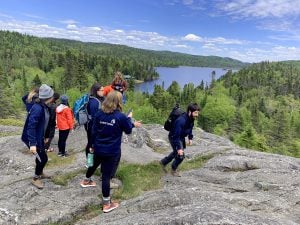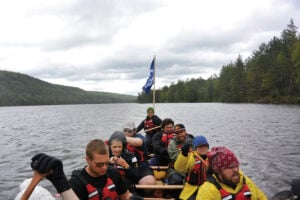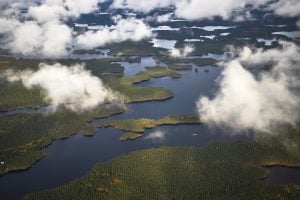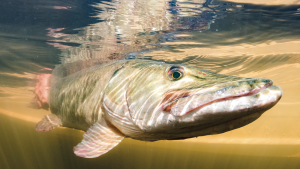
Environment
Ocean Bridge Diaries: Talen Rimmer
On the shores of Lake Superior, I found solace in how close our country can become when we all share food together
- 1561 words
- 7 minutes
This article is over 5 years old and may contain outdated information.
Travel

Before dawn on a cold November morning, a dozen photography enthusiasts scurry around the frosty shoreline of northern Ontario’s Michipicoten River, hunching over tripods, making long exposures and patiently awaiting the day’s first light. Beyond the clicking of shutters and the metallic ting of tripod legs on rock, Lake Superior sets a moody backdrop, sighing rhythmically in a long swell that stretches west to a watery horizon. I imagine the sun rising like a fiery spotlight over the mop-topped shoreline spruces, bathing golden beaches and teal-coloured rocks in light, and transforming the restless lake into a big sea of shining water — the stuff of Group of Seven artist Lawren Harris.
I tiptoe around in the darkness, manipulating my camera with increasingly numb fingers, noticing how the cold saps its battery power. I’m both disappointed and relieved when the inky sky finally transitions through an underwhelming sequence of pewter and gunmetal to lackluster grey, dashing our collective hopes of capturing a spectacular sunrise. The consolation, of course, is that it’s finally time to head indoors for breakfast.

We’ve gathered at Rock Island Lodge, a four-bedroom bed and breakfast and small conference facility perched atop the glacier-scoured rocks of Michipicoten Bay, just south of the town of Wawa, to practise the art of landscape photography. Our instructor is professional photographer Rob Stimpson; our prime subject is Lake Superior; and our shot lists range from shorelines and sweeping skies to intimate studies of ancient rocks and, we hope, intense images of surf and tumultuous waters. After all, the three-day workshop is called the Gales of November, a play on Gordon Lightfoot’s ballad The Wreck of the Edmund Fitzgerald and a nod to the big lake’s fickle late-autumn temperament.
Stimpson fell in love with Lake Superior’s northeastern shore while canoeing south along a 170-kilometre coastline of bold headlands and paradisiacal sand beaches from Pukaskwa National Park, near the town of Marathon, to Michipicoten. Captivated by the area, he struck up a partnership with Rock Island Lodge owner David Wells in 2002 to show that Lake Superior can supply the same sort of surly, dramatic weather that attracts droves of shutterbugs to coastal towns such as Tofino, B.C., or Peggys Cove, N.S. Over the 12 years Stimpson has taught this course, he’s seen plenty of ferocious storms, as well as mirror-calm waters, spectacular sunsets and early-season snow — including a 2005 blizzard that closed the local section of the Trans-Canada Highway and left participants marooned at the lodge for an extra day. “I can’t get enough of this place,” he says when we gather on the first day to discuss course expectations. “This is real Canada. It’s Ontario’s best-kept secret. The scenery here is right up there with the Cabot Trail or the Rockies.”
Stimpson’s passion for Lake Superior is obvious. It’s telling that he makes annual pilgrimages to Rock Island between guiding eco-tours in Antarctica, living in Muskoka and delivering landscape and wildlife photography courses all across Ontario’s wilderness fringes, from moose-viewing trips in Algonquin Provincial Park to fall-colour shoots in Killarney. The same attitude pervades Stimpson’s dedicated entourage of apprentices. London, Ont.-based photographer Brian Barker, for instance, has participated in the Wawa workshop five times. This year, he had booked to vacation in San Diego over the same dates. Then he showed his Lake Superior collection to his partner, Andrea Paturel, whose jaw-drop response incited a quick change in plans. “She saw the pictures and said, ‘I want to go there instead,’” laughs Barker.
Similarly, David Bates and Marta Vargas, a retired couple from Thunder Bay, have been part of two Gales workshops, and Toronto-based environmental consultant Peter Burtch has participated in three. “Lake Superior is a free spirit,” says Burtch, who helped shape the Ontario government’s efforts to establish semi-protected “heritage coast” status for the lake’s entire north shore in the late 1990s. “It’s wild and unpredictable, and provides a photographer with tremendous creative opportunities.”
For the benefit of a handful of workshop newbies — a couple from Detroit, a woman from Wawa and me — Stimpson delivers an opening lecture to cover the basics: the exposure pyramid (the three-way interaction of film speed or sensor sensitivity, known as ISO, shutter speed and lens aperture); using the rule of thirds for composition and resisting the urge to centre the subject; a discussion of the nature of colour; and how to use digitalspecific technology, such as white balance and histograms (a graphical rendition of an image’s range of shadows, mid-tones and highlights), to optimize photographs. After establishing these fundamentals, Stimpson promises the rest of the course will be largely hands-on and in the field. We’ll carpool to scenic beaches in Michipicoten Bay and visit deserted hiking trails in nearby Lake Superior Provincial Park, besides capturing the dynamic interaction of river and lake on the lodge’s grounds.
After our first morning shoot, Stimpson implores us to “get your camera out of P [automatic] mode” and make the leap to manual exposure settings. “As photographers, we want to be controlling our cameras,” he says, “not the other way around.”
At Sandy Beach, a kilometre-long swath of brown-sugar sand just north of Rock Island Lodge, I accept the additional challenge of sticking with one lens with the goal of, in Stimpson’s words, “getting to know how it sees.” Lake Superior offers little in the way of surf today, so I train my camera on coastal details instead, photographing gently waving beach grasses, the sensuous curves of an inflowing stream and the delicate detail of snow on balsam fir needles. I apply my new knowledge of white balance to warm the “temperature” of my digital images, making the most of the day’s flat light.
Toting his heavy tripod and camera, Stimpson drifts among the group, taking his own shots and providing guidance and feedback. Later on, he offers another short lecture on how to correct and manipulate photos using Photoshop, perhaps the biggest upshot to digital imagery. I experiment with software that enables spectacular definition in challenging light conditions by blending multiple exposures of the same scene to create a single, “highdynamic range” image file. Despite the power of the program, “your first goal is to get it right in the camera,” Stimpson says. “It’s not about taking 1,000 images and hoping for a good one.”
Between sessions photographing the towering 200-metre cliffs of Old Woman Bay and the cascades of the Sand River, Rock Island is our base camp. The lodge’s rooms and meals are more quaint and homestyle than posh and gourmet, a perfect mix for its primary clientele of adventurous sea kayakers and canoeists and outdoorsy families. Open spring, summer and fall, Rock Island has emerged as a favourite stop for road-trippers making the 1,600-kilometre Lake Superior circle tour of the Canadian and American shores. The communal front room where we download our shots and talk shop with Stimpson and our peers boasts sweeping, 270-degree views of Lake Superior. At mealtime, the same space becomes a hall for buffet-style dining. For Brian Barker, this collegial atmosphere is one of the Gales of November’s greatest appeals. “You get to talk and learn how other people see things,” he says. “Everyone interprets the environment in a different way.”
However comfortable and inspiring the surroundings, I get the sense that some participants are becoming frustrated with the dull, sunless skies and calm winds that persist well into our second full day of the course. At lunch, Stimpson predicts a breakthrough later in the afternoon. Sure enough, the clouds thin, and as the evening magic hour approaches, we’re all scrambling on the lakeside rocks, preparing for the sunset. A creative frenzy ensues. Clad in lumberjack plaid, Peter Burtch captures the sky’s powerful oranges, reds and purples; Barker records candid images of Burtch in silhouette, dwarfed by Superior’s quicksilver waters; and Stimpson and two other students balance their tripods on the treacherously slippery rocks next to the mouth of the Michipicoten River, where a cementand- steel light beacon intercepts the current.
The thing about good light, as all photographers know, is that it’s fleeting. The shooting spree ends abruptly when a thick band of clouds blots out the sun at the horizon with flick-of-the-switch efficiency. But the darkness can’t curb the group’s excitement, and we’re still buzzing with energy as we retreat to the lodge to download our photos and relive the moment on our computer screens. “Another good day on the lake,” booms Burtch as we tromp inside, just in time for dinner. “But aren’t they all?”
Fundy Trail workshop
The André Gallant — Freeman Patterson Workshop takes place at the beginning of the Fundy Trail in New Brunswick, where the daily changing tides provide dramatic scenery of the shore, caves and fishing boats in the area.
Dates: Aug. 25-31, Sept. 8-14, Oct. 6-12, and Oct. 13-19, 2013
Max number: 12
Price: $1,995 + HST
Photographers/guides: André Gallant and Freeman Patterson
Website: freemanpatterson.com/nb_workshop.htm
Loon Photography tour in Algonquin Park
Go loony in Algonquin Park on this tour, which features a special boat with a silent electric motor that’s perfect for loon photographers, allowing them to get low-angle photography and hold a lens 36 centimetres above the water’s surface.
Dates: Sept. 7 and 8, 2013; Sept. 13 and 14, 2013
Max number: 4
Price: $500
Photographers/guide: Michael Bertelsen
Website: algonquinparkphototours.com/wildlife-workshops-tours/loon-photography.htm
Caribou, Autumn Colours & Aurora tour
Have close encounters with muskoxen, caribou and other wildlife on the tundra in Canada’s Far North.
Dates: Sept. 6-13, 2013, Aug. 22-29, 2014, Aug. 29-Sept. 5, 2014, and Sept. 5-12, 2014
Max number: 8
Price: $4,995 for single occupancy, $9,000 for double occupancy
Photographers/guide: TBD
Website: www.thelon.com/caribou.htm
Ultimate Grizzly & Spirit Bear photo tour
Photographers spend six days photographing grizzlies and spirit bears in the wild of the Great Bear Rainforest, B.C.
Dates: Oct. 4-11, 2013
Max number: n/a
Price: $6,314 USD (approx. $6,527 Canadian)
Photographers/guide: Wild Focus guide
Website: wildfocus.com/tours/grizzlies-and-spirit-bears-of-british-columbia-photo-tour-2013
Jasper Wildlife photo workshop
From bighorn sheep to black bears, see the best of Jasper’s wildlife on this five-day photography tour, with the mountain landscape as your canvass.
Dates: Oct. 22-27, 2013
Max number: 5
Price: $1,995 + GST
Photographers/guide: John E. Marriott
Website: canwildphototours.com/
jasperphotoworkshops.shtml
Fire and Ice in the Canadian Rockies
Capture Alberta’s Kootenay Plains just as the winter season begins, when colourful skies break at dusk and dawn, and Abraham Lake is a combination of open water and ice.
Dates: Nov. 6-10, 2013
Max number: 8
Price: $1,519 plus tax
Photographers/guide: Darwin Wiggett
Website: www.oopoomoo.com/workshop/fire-and-ice-photo-tour/
Bugaboo photo workshop
This three-day nature photography tour flies photographers by helicopter to mountainous areas in eastern British Columbia where they can capture bugaboo flowers and mountain scenery at the peak of wildflower season.
Dates: Aug. 5-8, 2014
Max number: 10
Price: $3,280 plus tax
Photographers/guide: John E. Marriott
Website: blog.canadianmountainholidays.com/2013-summer-photo-workshop?utm_campaign=2013-Photo-Workshop
Little traffic, empty beaches and dramatic skies make autumn a great season to make the 700-kilometre road trip between Thunder Bay and Sault Ste. Marie (or vice versa) along Lake Superior’s north shore. The following itinerary begins in Thunder Bay: Start with a layover in the city’s newly redeveloped downtown and harbour district at the luxurious McVicar Manor Bed and Breakfast. In the village of Rossport, 200 kilometres east on the Trans-Canada Highway, get a room with a view of Superior at The Willows Inn B&B and dine at the eclectic Serendipity Gardens Café. The next day, take an hour to hike the scenic Southern Headland Trail in Pukaskwa National Park before continuing to Wawa’s Rock Island Lodge. The route to Sault Ste. Marie is one of the most spectacular drives in Canada, with great roadside vantage points at Old Woman, Agawa and Alona bays. End with a stay at the city’s Algoma’s Water Tower Inn & Suites, which features a gallery of the work of local photographers and adventurers Gary and Joanie McGuffin.
View the stunning scenery of Lake Superior through the lens of writer Conor Mihell.





Are you passionate about Canadian geography?
You can support Canadian Geographic in 3 ways:

Environment
On the shores of Lake Superior, I found solace in how close our country can become when we all share food together

People & Culture
How a journey through the Great Lakes helped reshape my relationship with water after the loss of my father

People & Culture
Uprooted repeatedly by development projects, the Oujé-Bougoumou Cree wandered boreal Quebec for 70 years before finding a permanent home. For some, the journey continues.

Environment
How a cocktail of invasive species and global change is altering the Great Lakes-St. Lawrence River ecosystem